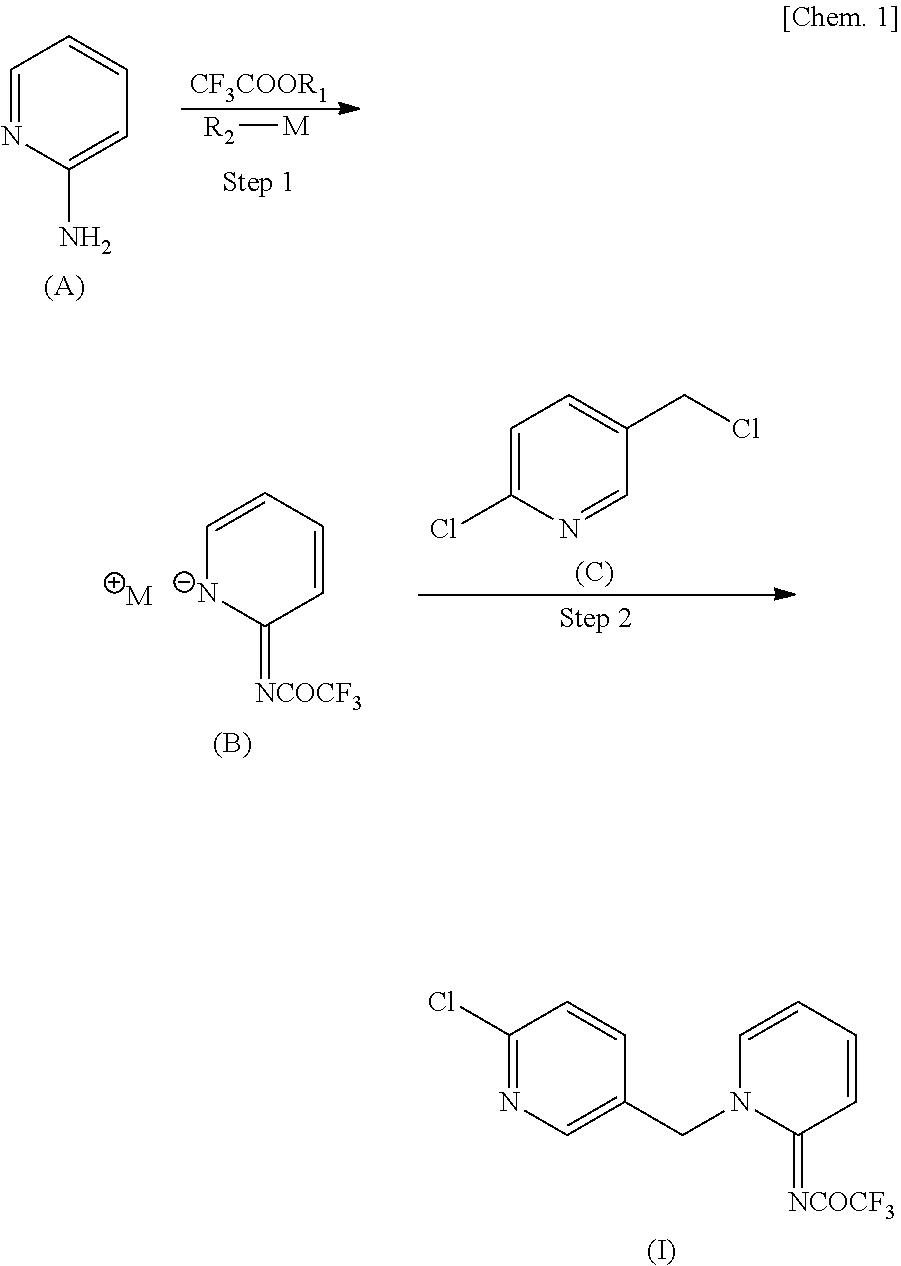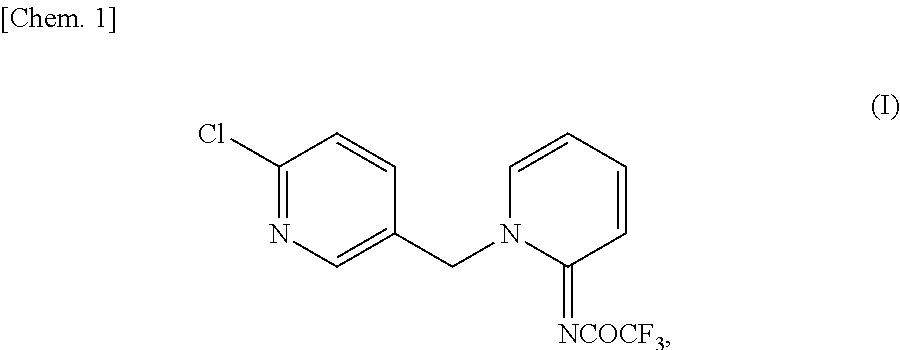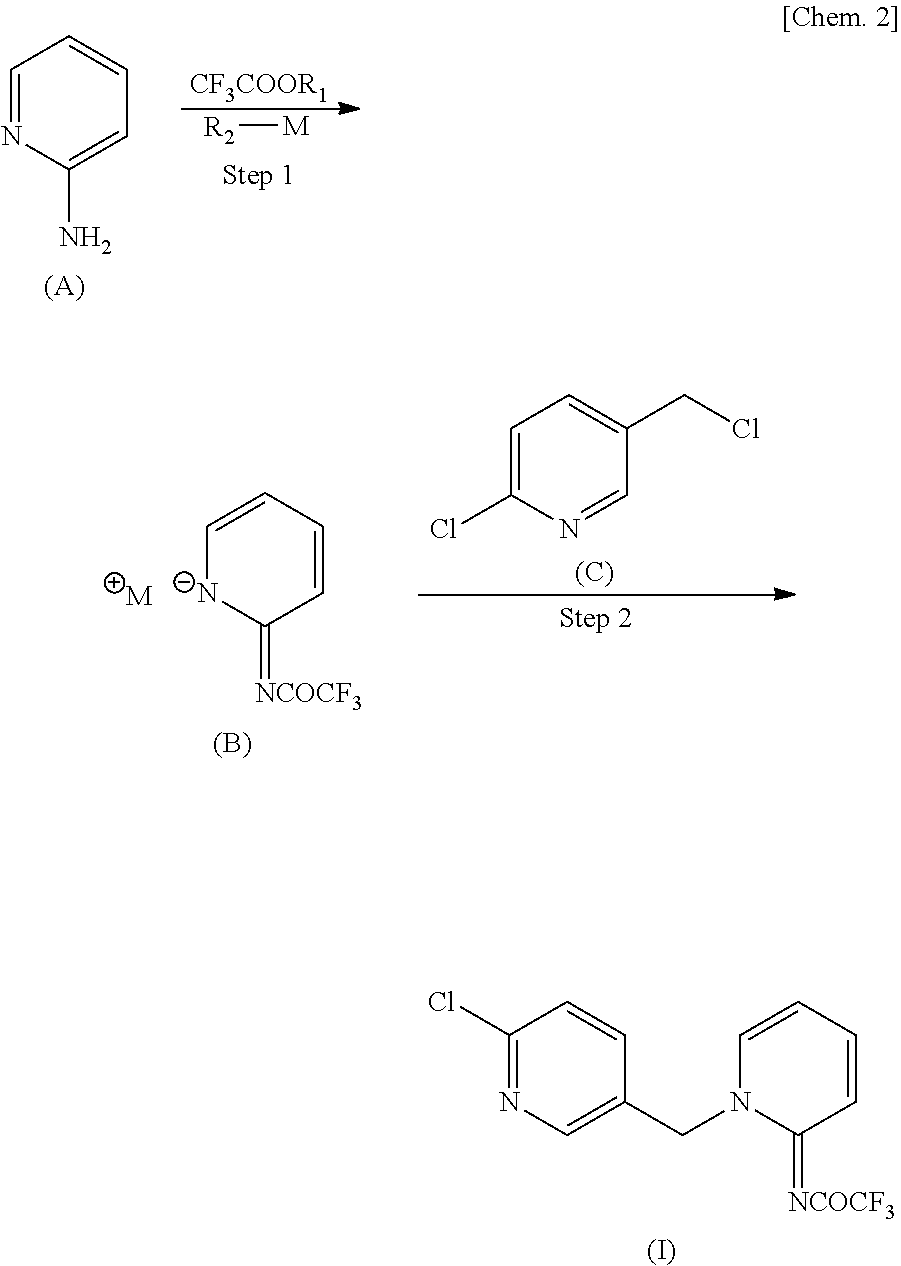Optimized production method for pest control agent
- Summary
- Abstract
- Description
- Claims
- Application Information
AI Technical Summary
Benefits of technology
Problems solved by technology
Method used
Image
Examples
example 1
[0043]Added were 31.24 g (0.22 mol) of ethyl trifluoroacetate, 18.82 g (0.20 mol) of 2-aminopyridine, and 16 g of N,N-dimethylformamide (DMF) in this order, and after dissolution, 38.57 g (0.20 mol) of sodium methoxide (28.0% methanol solution) was added dropwise thereto at room temperature. After stirring at 25° C. for 1 hour, methanol and ethanol were distilled off under reduced pressure. A solution prepared by dissolving 32.70 g (0.20 mol) of 2-chloro-5-chloromethyl pyridine in 18.8 g of DMF was added thereto, followed by stirring at 60° C. for 3 hours and 15 minutes. Thereafter, 110 ml of water was added, and after stirring at room temperature for 3 hours, the precipitate was collected by filtration. After pushing and washing twice with 40 ml of water, vacuum drying at 70° C. overnight was performed to obtain 59.81 g of the desired product (yield 94.7% and purity 98.6%).
examples 8 to 10
[0046]Added were 31.24 g (0.22 mol) of ethyl trifluoroacetate, 18.82 g (0.20 mol) of 2-aminopyridine, and 16 g of DMF in this order, and after dissolution, 38.57 g (0.20 mol) of sodium methoxide (28.0% methanol solution) was added dropwise thereto at room temperature. After stirring at each temperature shown in Table 3 (5° C., 25° C., 45° C., or 55° C.), methanol and ethanol were distilled off under reduced pressure. A solution prepared by dissolving 32.70 g (0.20 mol) of 2-chloro-5-chloromethyl pyridine in 18.8 g of DMF was added thereto, followed by stirring at 60° C. Thereafter, 110 ml of water was added, and after stirring at room temperature for 3 hours, the precipitate was collected by filtration. After pushing and washing twice with 40 ml of water, vacuum drying at 70° C. overnight was performed to obtain as a result the desired products having the yields and purities shown in Table 3.
TABLE 3Reaction Temperaturein Step 1YieldPurityExample 8 5° C.87.3%98.9%Example 125° C.94.7%...
example 13
[0048]Added were 14.09 g (0.11 mol) of methyl trifluoroacetate, 9.41 g (0.10 mol) of 2-aminopyridine, and 13 g of DMF in this order, and after dissolution, 19.29 g (0.10 mol) of sodium methoxide (28.0% methanol solution) was added dropwise thereto at room temperature. After stirring at 25° C. for 40 minutes, ethanol was distilled off under reduced pressure. A solution prepared by dissolving 16.17 g (0.10 mol) of 2-chloro-5-chloromethyl pyridine in 9.4 g of DMF was added thereto, followed by stirring at 60° C. for 2 hours and 20 minutes. Thereafter, 60 ml of water and 6 ml of methanol were added, and after stirring at room temperature for 1 hour, the precipitate was collected by filtration. After pushing and washing twice with 30 ml of water and twice with 20 ml of 60 v / v % aqueous solution of methanol, vacuum drying at 70° C. for 8 hours was performed to obtain as a result 28.85 g of the desired product (yield 91.4% and purity 98.6%).
PUM
 Login to View More
Login to View More Abstract
Description
Claims
Application Information
 Login to View More
Login to View More - R&D
- Intellectual Property
- Life Sciences
- Materials
- Tech Scout
- Unparalleled Data Quality
- Higher Quality Content
- 60% Fewer Hallucinations
Browse by: Latest US Patents, China's latest patents, Technical Efficacy Thesaurus, Application Domain, Technology Topic, Popular Technical Reports.
© 2025 PatSnap. All rights reserved.Legal|Privacy policy|Modern Slavery Act Transparency Statement|Sitemap|About US| Contact US: help@patsnap.com



